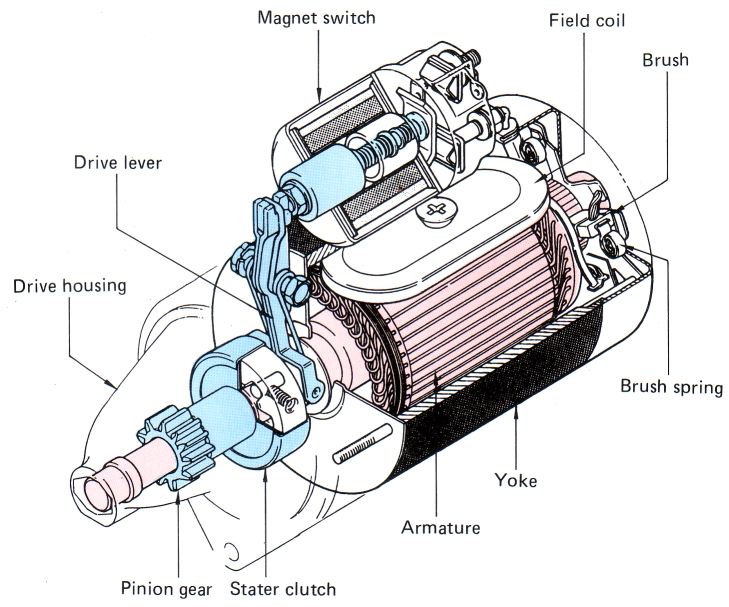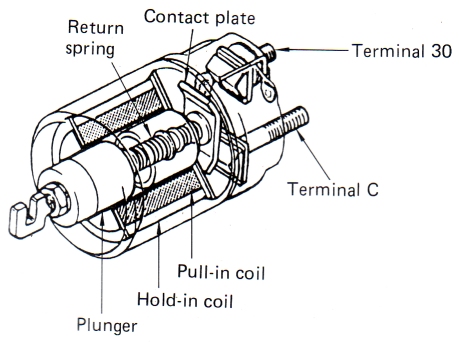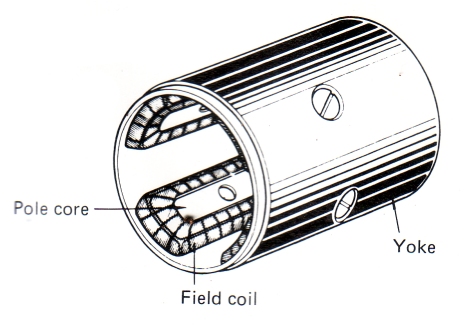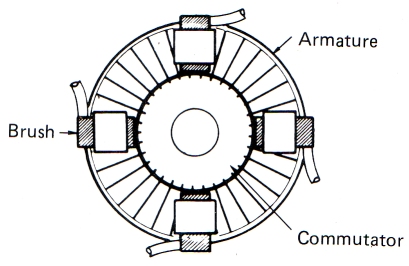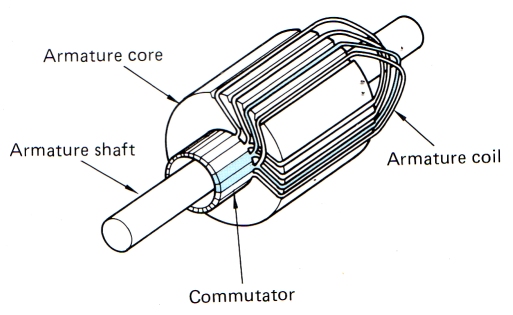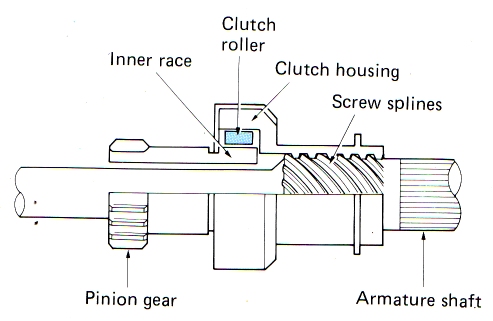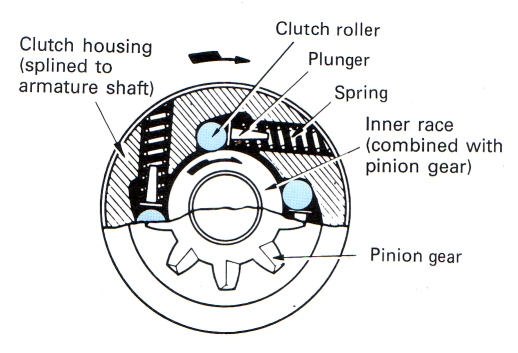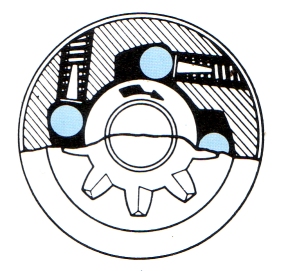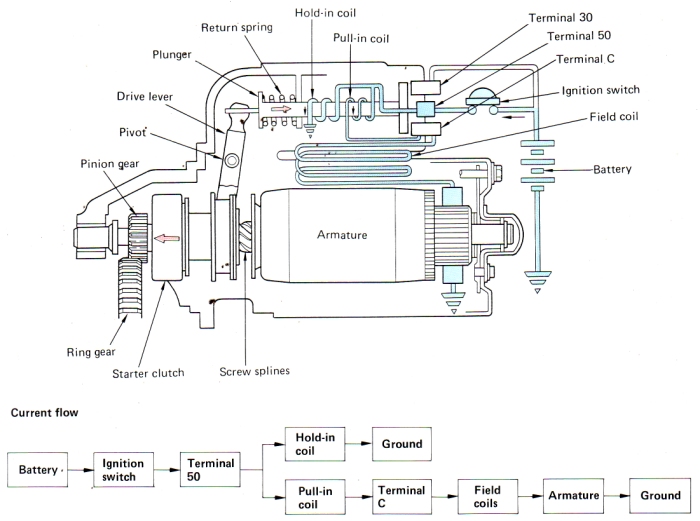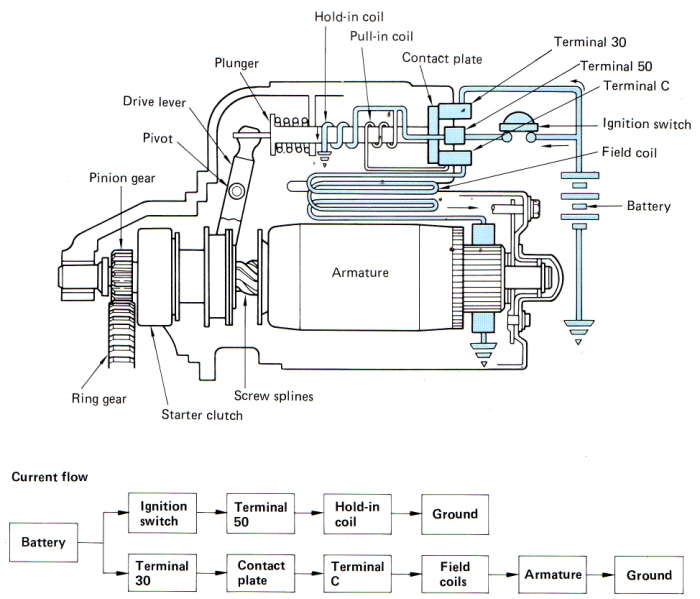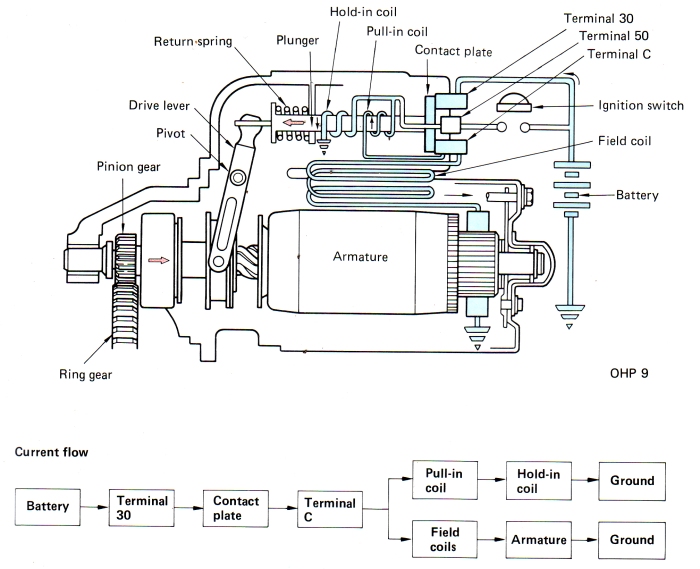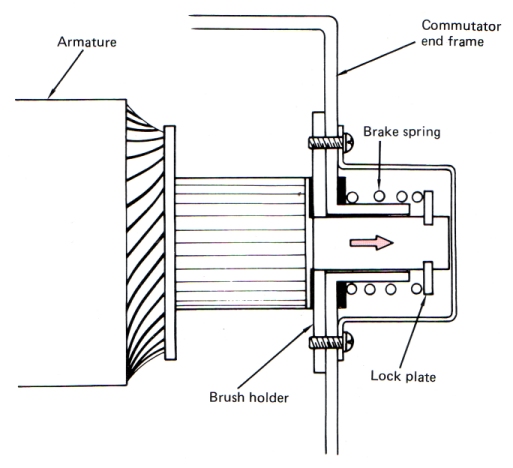Tech:Electrical/Starter Motor/Conventional Type
Conventional Type
Construction
This type of starter motor contains a magnetic switch, Electric motor, Drive lever, Pinion gear, Starter clutch etc. The pinion gear is located on the same axis as the armature and rotates at the same speed as it. The drive lever connected to the magnetic switch plunger pushes the pinion gear and and causes it to mesh with the ring gear.
1. Magnetic switch.
The magnetic switch (Also referred to as a Solenoid) consists of a hold-in coil, Pull-in coil, A return Spring, A plunger and other components. It is activated by the magnetic forces generated in the coils and carries out the following two functions:
- It pushes the pinion gear so that it meshes with the ring gear.
- It serves as a main switch or relay, Allowing heavy current to pass from the battery to the starter motor.
2. Field Coils.
The electrical current from the magnetic switch flows through the field coils, Which generate the magnetic field required to rotate the armature.
3. Brushes.
The brushes, pressed against the segments of the armature commutator by the brush springs, Allow the current to pass from the field coils to the armature.
Weakened brush springs or worn brushes
may lead to insufficient electrical contact
between the brushes and the segments of the
commutator. The resulting excessive electrical
resistance at the contact points will reduce
the supply of current to the motor,
Impeding torque build-up.
4. Armature.
The armature, The revolving component of the motor, Consists of the armature core, Armature coils, Commutator, etc. It revolves as a result of the interaction between the magnetic fields generated by the armature coils and the field coils.
5. Starter Clutch.
The starter motor must crank the engine until the engine fires and starts to run on its own. Once the engine has started, However, It would force the starter motor to rotate at a much higher speed than that for which it is designed, Which would damage the starter motor. The starter clutch is a one-way clutch which protects the starter motor from this. Although the construction of the starter clutch used for the conventional type starter motor is somewhat different from that used for the reduction type starter motor, The principle and operation of each is essentially the same.
Although the construction of the starter clutch used for the conventional type starter motor is somewhat different from that used for the reduction type starter motor, The principle and operation of each is essentially the same.
- Starter Clutch During Cranking
The rotating armature tries to force the clutch housing to which it is splined, To rotate faster than the inner race, Which is combined with the pinion gear. The clutch rollers are therefore forced to roll toward the narrower sections between the clutch housing and inner race until they jam between the clutch housing and the inner race. As a result, The rollers transfer the rotational movement of the clutch housing to the inner race and thence to the pinion gear.
- Starter Clutch After Engine Is Started.
Once the engine has started, Its torque tries to force the inner race to rotate faster than the clutch housing. The clutch rollers therefore roll against the springs towards the wider sections inside the housing. As a result, The clutch housing and the inner race disengage to prevent the starter clutch from transmitting the engine torque from the pinion gear to the starter motor.
Operation
- 1. Ignition Switch In START Position
When the ignition switch has been turned to the START position, Terminal 50 passes electrical current from the battery to the hold-in and pull-in coils. From the pull-in coil, The Current then flows to the field coils and armature coils via Terminal C.
At this point the voltage drop across the pull-in coil keeps the amount of electrical current flowing through the motor components (Field coils and armature) small, So the motor rotates at a lower speed. At the same time, The magnetic fields generated by the hold-in and pull-in coils pull the plunger toward the right against the return spring. This movement causes the pinion gear to move toward the left, Via the drive lever and mesh with the ring gear. The low starter motor speed at this stage means that the gears mesh smoothly. The screw splines help the pinion and ring gears to mesh smoothly.
- 2. Pinion And Ring Gears Engaged
When the magnetic switch and the screw splines have pushed the pinion gear to the position where it meshes completely with the ring gear, The contact plate attached to the end of the plunger turns the main switch on by short circuiting the connections between Terminals 30 and C. The resulting connection causes a heavier current to pass through the starter motor, Which causes the motor to rotate with a greater torque. The screw splines help the pinion gear mesh more securely with the ring gear. At the same time, The voltage levels at both ends of the pull-in coil become equal so that no current flows through this coil. The plunger is therefore held in position only by the magnetic force exerted by the hold-in coil.
- 3. Ignition Switch In ON Position
Turning the ignition switch back to the ON position from START cuts off the voltage being applied to Terminal 50. The main switch remains closed, However, Some current flows from Terminal C to the hold-in coil via the pull-in coil. Since current flows through the hold-in coil in the same direction as when the ignition switch is in the START position, It generates a magnetic force which pulls the plunger. In the pull-in coil, On the other hand, Current flows in the opposite direction, Generating a magnetic force which tries to return the plunger to its original position.
The magnetic fields set up by these two coils cancel each other out, So the plunger is pulled backward by the return spring. Therefore, The heavy current which has been supplied to the motor is cut off and the plunger disengages the pinion gear from the ring gear at about the same time.
- 4. Armature Brake
A second attempt at starting the engine while the pinion gear is still rotating due to inertia could lead to faulty meshing of the pinion gear with the ring gear. To prevent this, The conventional type starter motor incorporates a brake mechanism with the construction shown below.
When the return spring housed inside the magnetic switch retracts the pinion gear, The brake spring pulls the armature against the brush holder. Since the brush holder is fixed to the commutator end frame, The armature immediately stops turning.
Back to Starter Motor
Back to Main Page
